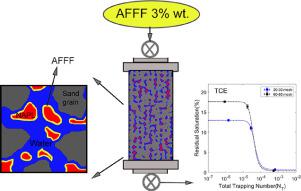Water Research ( IF 12.8 ) Pub Date : 2021-02-25 , DOI: 10.1016/j.watres.2021.116975 Shuchi Liao , Zachary Saleeba , J. Daniel Bryant , Linda M. Abriola , Kurt D. Pennell

|
At sites where aqueous film forming foams (AFFFs) are used for fire suppression or training activities, interactions between dissolved foam constituents and organic liquids could alter contaminant migration in the subsurface. In this study, batch reactor and column experiments were conducted to investigate the potential for AFFF solutions to enhance the solubility and mobility of three representative non-aqueous phase liquid (NAPLs), JP-4 jet fuel, trichloroethene (TCE), and tetrachloroethene (PCE). For AFFF concentrations up to 5% wt. (50,000 mg/L), aqueous solubilities of TCE and PCE increased by less than 50%, indicating the absence of micellar solubilization. However, NAPL-water interfacial tensions were reduced to less than 1.5 mN/m and resulted in accumulation of up to 2.25 mg/m2 of AFFF at the NAPL-water interface. To assess the potential for AFFF to mobilize residual (entrapped) NAPL at a field application rate of 3% wt. (30,000 mg/L), columns were packed with two size fractions of Ottawa sands (20–30 mesh and 60–80 mesh) that yielded residual NAPL saturations ranging from 11.7 to 17.6%. Following injection of 3 pore volumes of the 3% wt. AFFF solution, partial mobilization of residual NAPL was observed for PCE, TCE, and JP-4, with saturation reductions of 0.7 to 2% in 20–30 mesh and 0.3% to 1.3% in 60–80 mesh Ottawa sand. The columns were then flushed with an ultralow-IFT surfactant solution consisting of 4% wt. 1:1 Aerosol AY/OT, which resulted in nearly complete mobilization of the remaining residual NAPL. When NAPL desaturation curves were expressed in terms of the total trapping number (NT), the threshold value of NT required for NAPL mobilization by 3% wt. AFFF was approximately 2 × 10−5, consistent with previous studies. These findings demonstrate that AFFF solutions can lead to partial mobilization of residual NAPL, and that the total trapping number concept can be used to predict such behavior a priori. In addition, the observed IFT reductions are sufficient to alter NAPL accumulation and redistribution behavior in the subsurface through enhanced spreading above the water table (e.g., JP-4) or penetration into lower-permeability media (e.g., TCE, PCE).
中文翻译:

水性成膜泡沫对非水相液体污染物在石英砂中溶解度和迁移的影响
在使用水性成膜泡沫(AFFF)进行灭火或训练活动的场所,溶解的泡沫成分与有机液体之间的相互作用可能会改变地下污染物的迁移。在这项研究中,进行了间歇反应器和色谱柱实验,以研究AFFF溶液增强三种代表性非水相液体(NAPLs),JP-4喷气燃料,三氯乙烯(TCE)和四氯乙烯( PCE)。对于AFFF浓度,最高可达5%wt。(50,000 mg / L),TCE和PCE的水溶性增加不到50%,表明没有胶束增溶作用。但是,NAPL-水的界面张力降低至小于1.5 mN / m,并导致累积量高达2.25 mg / m 2。在NAPL-水界面处的AFFF。为了评估AFFF以3%wt。%的田间施用量动员残留(捕获的)NAPL的潜力。(30,000 mg / L),色谱柱中填充了两种大小的渥太华砂(20–30目和60–80目),产生的残余NAPL饱和度范围为11.7至17.6%。在注入3%重量的3个孔体积之后。AFFF溶液,PCE,TCE和JP-4的残留NAPL被部分动员,在20-30目中的饱和度降低0.7%至2%,在60-80目渥太华砂中降低0.3%至1.3%。然后用4%(重量)的超低IFT表面活性剂溶液冲洗柱子。1:1气溶胶AY / OT,几乎可以完全动员剩余的残留NAPL。以总捕集数(NT),NAPL动员所需的N T阈值增加3%wt。AFFF约为2×10 -5,与先前的研究一致。这些发现表明,AFFF解决方案可导致残余NAPL的部分动员,并且总捕获数概念可用于先验预测这种行为。另外,观察到的IFT降低足以通过增加地下水位上方的扩散(例如JP-4)或渗透到较低渗透率的介质(例如TCE,PCE)来改变地下NAPL的积累和再分布行为。


























 京公网安备 11010802027423号
京公网安备 11010802027423号